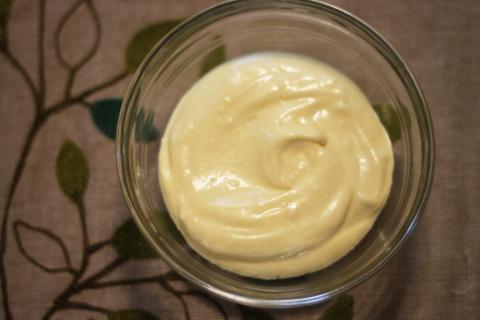
Mayonnaise is an emulsification of egg yolk and oil. Though easily made, it does require a few preparations to be done just right. Unlike popular belief, it is a healthy sauce rich in nutrients and is used in a variety of recipes as a base, dip and dressing.
There are many recipes for mayonnaise -- some use flour to obtain the proper texture, others warm the yolk to kill the bacteria and increase the use time, and others use the whole egg.
My favorite recipe uses all organic ingredients (provided below):
3 Egg yolks
1 Cup sunflower oil
1 Tablespoon flour
1 Tablespoon lemon juice
2 Tablespoons apple cider vinegar
1 Tablespoon mustard (1/4 Tbs. if using powdered mustard)
1-2 Tablespoons of sugar (to taste)
1-2 Tablespoons of salt (to taste)
*Many of these ingredients should be adjusted depending on the consistency that you prefer*
Set egg yolks in a large bowl. Very slowly, drop by drop, add sunflower oil until the concoction reaches a lumpy consistency like that of pie crust dough before thoroughly blended. The flavor mixture of flour, mustard, sugar, salt, apple cider vinegar and lemon juice is added one tablespoon at a time until blended. The mayonnaise will make about four to six ounces and will last about a week.
Mayonnaise is rich in vitamins and minerals from the egg yolk and the oil. Vitamins E and A and trace vitamins from the oil add to the minerals and protein from the egg to make it a healthy addition to salads and other recipes. The list of nutrients includes calcium, magnesium, phosphorus, potassium, zinc, copper and iron.
Commercially made mayonnaise is not necessarily as nutritional as homemade because the oils used are usually soy, corn and other vegetable oils that are high in omega-6 fats. These fats are essential for good health but are supplied in over-abundance in the American diet. Too much omega-6 fat throws off the balance of omega-3 fats and puts individuals at risk for developing serious illnesses. To this, commercially made mayonnaise adds processed sugar, preservatives and monosodium glutamate (MSG), adding months to the shelf-life of the product. It is not unusual for consumers to experience headaches, nausea and weakness after eating foods made with commercially made mayonnaise.
Mayonnaise is used as a base for salads like egg salad and potato salad. It adds a fullness of flavor to dips for chips and vegetables. It makes a green salad dressing by combining it with tomato sauce and mustard. Mayonnaise, ketchup and onions make a delicious fry sauce. Combined with capers and parsley, mayonnaise creates a tasty tartar sauce for seafood. Coating chicken with mayonnaise before covering with breadcrumbs can give added depth to fried chicken.
Homemade mayonnaise is quick and easy to make and a healthy addition to many recipes – and even better, making your own mayonnaise assures you of the quality of the ingredients.
Cover Image Source: Flickr
